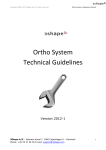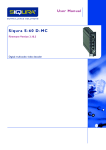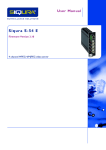Download Paragon Migrate OS to SSD 4.0
Transcript
PARAGON Software GmbH Heinrich-von-Stephan-Str. 5c 79100 Freiburg, Germany Tel. +49 (0) 761 59018201 Fax +49 (0) 761 59018130 Internet www.paragon-software.com Email [email protected] Paragon Migrate OS to SSD 4.0 User Guide Copyright© 1994-2015 Paragon Software GmbH. All rights reserved. 2 Contents Introducing Paragon Migrate OS to SSD ............................................................................. 3 What is Migrate OS to SSD? .................................................................................................................... 3 What’s New in Migrate OS to SSD 4.0 ...................................................................................................... 3 Product Components .............................................................................................................................. 3 Key Features ........................................................................................................................................... 3 Challenges of Windows OS Migration ................................................................................ 4 Getting Started .................................................................................................................. 5 System Requirements ............................................................................................................................. 5 Installation ............................................................................................................................................. 5 First Start ................................................................................................................................................ 6 Obtaining WinPE Bootable Environment ................................................................................................. 6 Launching WinPE Environment ................................................................................................................ 6 Using Migrate OS to SSD .................................................................................................... 8 Migrating Windows OS to SSD ................................................................................................................. 8 Extra Scenarios for WinPE ..................................................................................................................... 11 Correcting EFI parameters ...............................................................................................................................................11 Correcting the Boot Configuration Data (BCD) ................................................................................................................12 Adding specific drivers .....................................................................................................................................................13 Configuring network ........................................................................................................................................................14 Saving log files..................................................................................................................................................................17 Copyright© 1994-2015 Paragon Software GmbH. All rights reserved. 3 Introducing Paragon Migrate OS to SSD This chapter will present general information on our product. What is Migrate OS to SSD? Paragon Migrate OS to SSD helps to perform fast and safe Windows migrations to new storage devices (HDD or SSD) and even downsizes to smaller capacity drives, thanks to advanced data exclusion capabilities. You can transfer a live system with no impact to your work, and have your partitions automatically aligned in the process if needed. To keep up with the market demands, in this version the product’s functionality has been extended by the support of the latest Windows 8 and uEFI/GPT configurations. Our company is constantly releasing new versions and updates to its software, that's why images shown in this manual may be different from what you see on your screen. What’s New in Migrate OS to SSD 4.0 Microsoft Windows 10 support. Our product supports Windows 10 Insider Preview. Product Components Windows™-based utility – the primary tool for migrating Windows OS to fast solid state drives. WinPE environment – with Recovery Media Builder you can prepare WinPE-based environment on a USB thumb drive to do migrations without installing the product. This media also contains Boot Corrector to help you fix most of the system boot problems that can be a result of a human factor, program error or a boot virus activity. Recovery Media Builder can be obtained here: www.paragon-software.com/my-account/. Key Features Migrates Windows to larger or smaller storage devices in a single operation Supports any Windows since XP (including Windows 8 and Windows Server 2012) Migrates a 64-bit Windows configured to the uEFI-based boot mode Automatically aligns partitions on the destination disk if necessary Automatically detects and copies MSR for successful migrations of Windows 7 Allows the user to exclude data during the process in order to fit to the destination disk Processes locked (in-use) disks with MS VSS to migrate without rebooting Windows Includes Paragon's time-proven move/resize functionality Guarantees safety for the system and data Copyright© 1994-2015 Paragon Software GmbH. All rights reserved. 4 Challenges of Windows OS Migration Challenge #1. Windows migration from HDD to a smaller SSD Migrating software to outside storage devices can be a slow and painful process to the unprepared. Hard disk drives (HDD) double in capacity every two years - giving software developers lots of room for developing technology which is often more complicated and space-consuming. To keep up with burgeoning software, users may think they are simply doomed to regular hardware upgrades involving the purchase of a new drive, and the headaches that go along with re-installing OSs and applications. Fortunately, there's a way to save time and effort by using special migration tools. Many of these tools performed well when migrating to larger drives, that is - until solid state drives (SSD) appeared on the scene. The latest SSDs do not boast high capacity, but rather smaller size and faster processing speeds over regular hard drives. Plus, they are completely indifferent to mechanical impact, a feature crucial for mobile computers. These benefits are leading more and more users to consider migrating their OS to SSDs to get the most out of their systems. The main obstacle users are faced with is the modest capacity of SSDs for the price. So, how do you migrate an OS and hundreds of gigabytes of data on one huge volume to a SSD drive of 80-128GB? Up until now, the only solution was to re-partition the HDD first, and then perform the migration using a special utility to separate the system and data, a process which risked data loss and was quite time consuming. Challenge #2. 64-bit Windows migration configured to the uEFI boot mode Introduced back in 2005 by Intel to lift restrictions of the old MBR (Master Boot Record) and PC BIOS (Basic Input/Output System), uEFI (Unified Extensible Firmware Interface) is now a recommended platform for new 64-bit Windows 8 computers. And the reason is easy to catch – besides other unique features impossible for the traditional tandem of BIOS+MBR, only a uEFI-based platform enables to accommodate Windows OS on a partition larger than 2.2TB. Despite all uEFI advantages however, it has one quite naughty issue – a pretty standard operation with a bootable device, for instance involving its connection to another SATA port results in unbootable Windows. You’ll get the same result if trying to boot from a cloned system hard disk. All these problems originate from the way uEFI+GPT bundle is organized. Microsoft provides how-to guides to tackle this type of problems, but they demand a great deal of experience from the user, involving the use of the cmd, diskpart and bcdedit tools. Paragon’s solution By developing a unique technology that transfers Windows (any version since XP) to a smaller capacity disk in a single operation, you can now simply and efficiently migrate Windows OS from a high capacity HDD to a speedy new SSD. Moreover, with the support of the uEFI/GPT configurations, you don’t have to bother about any boot issues. Copyright© 1994-2015 Paragon Software GmbH. All rights reserved. 5 Getting Started System Requirements For the Windows installation package Operating systems: - Windows XP - Windows Server 2003 - Windows Vista - Windows Server 2008 - Windows 7 - Windows Server 2008 R2 - Windows SBS 2011 - Windows 8 - Windows 8.1 - Windows Server 2012 R1/R2 - Windows 10 Insider Preview Intel Pentium CPU or its equivalent, with 300 MHz processor clock speed 128 MB of RAM (256+ recommended) Hard disk drive with 250 MB of available space SVGA video adapter and monitor Keyboard Mouse During the installation additional free space will be required. For the WinPE bootable environment Intel Pentium III CPU or its equivalent, with 1000 MHz processor clock speed At least 512 MB of RAM SVGA video adapter and monitor Keyboard Mouse Installation Before installation, please make sure your platform meets the minimum system requirements. If your computer meets these requirements, please do the following to install Migrate OS to SSD Windows installation package: 1. Click on the setup file to initiate the installation. Copyright© 1994-2015 Paragon Software GmbH. All rights reserved. 6 2. The Welcome page will inform that the application is being installed. Click Next to continue. 3. Please read the Paragon License Agreement carefully and then select the appropriate option to accept it. By not accepting the Paragon License Agreement you won’t be able to proceed with the installation. By clicking the Print button, the license agreement may also be printed out. 4. Provide Registration Information. On the Registration page you are to provide your product key and serial number, if applicable. 5. Provide Customer Information. On the Customer Information page you are to provide standard information, i.e. a user name and an organization. You must also decide whether to make the program available for all users of this computer (if applicable) or only for the current user. 6. Default Installation Path. Click Change to install the utility to a different location (by default C:\Program Files(x86)\ Paragon Software\Migrate OS to SSD 4.0 \). Otherwise, click Next to continue using the default path. 7. Install the Program. On the Ready to Install the Program page click Install to start the installation or click Back to return to any of the previous pages to review or modify the installation settings. 8. Installation Complete. The Final page reports the end of the setup process. Click Finish to complete the wizard. First Start To start Paragon Migrate OS to SSD under Windows, please click the Windows Start button and then select Programs > Paragon Migrate OS to SSD™ 4.0 > Paragon Migrate OS to SSD™. Obtaining WinPE Bootable Environment A WinPE-based image should be prepared on-site with Paragon’s Recovery Media Builder, which you can download from Paragon’s web site, the My Account section (www.paragon-software.com/my-account/).To know more on the subject, please consult documentation that comes with Recovery Media Builder. Launching WinPE Environment The WinPE environment includes the Migrate OS to SSD Wizard, Boot Corrector, Log Saver, and Network Configurator. It offers an excellent hardware support and allows injecting drivers for special storage controllers and network cards. Copyright© 1994-2015 Paragon Software GmbH. All rights reserved. 7 Please consult the Additional Options section for more information. Copyright© 1994-2015 Paragon Software GmbH. All rights reserved. 8 Using Migrate OS to SSD Migrating Windows OS to SSD The latest SSDs do not boast high capacity, but rather smaller size and faster processing speeds over regular hard drives. Plus, they are completely indifferent to mechanical impact, a feature crucial for mobile computers. These benefits are leading more and more users to consider migrating at least OS to SSDs to get the most out of their systems. So, how do you migrate a Windows OS and hundreds of gigabytes of data on one huge volume to an SSD drive of 80128GB? Our Migrate OS to SSD Wizard can help you do that with minimal effort. To migrate any Windows OS since XP from a regular hard disk to a fast SSD, please do the following: 1. Connect an SSD drive to the computer. 2. Turn on the computer. 3. Launch Migrate OS to SSD. 4. The first page of the wizard informs the user on the upcoming operation. Please read all notes carefully before you proceed. To get additional information on the subject, click the Learn more about migrating OS link at the bottom of the window (highly recommended). Once you’re done with that, click Next to continue. All data stored on the destination disk will be lost during the operation. Please save it to another location beforehand. 5. The wizard will scan your computer for system partitions that accommodate any of the supported Windows OSes. If several are found, it will let you specify which operating system you'd like to migrate. Copyright© 1994-2015 Paragon Software GmbH. All rights reserved. 9 6. Depending on your choice, it will then automatically pick one or two on-disk partitions (Windows 7 may have Microsoft System Reserved, a special hidden partition that contains boot critical files, while in the uEFI+GPT mode there will be another hidden partition, called EFI System Partition) and prompt you to select a destination disk (if there are more than two drives besides the source). 7. If the selected disk is not enough in capacity to hold your OS (just our case) or you’d like to remove redundant data from the process, click on the corresponding link to additionally exclude files from the system partition. 8. Unmark checkboxes opposite unnecessary files or folders to try to fit into the destination disk. We do not recommend you to exclude system files, but those that could take plenty of disk space, like video, music, photos, etc. Once you’re ready with the exclusion, click OK to let the wizard calculate the resulted size of the partition. Copyright© 1994-2015 Paragon Software GmbH. All rights reserved. 10 9. If a success, you’ll see a note that everything’s ready to start the migration. 10. Since we’re going to use our SSD drive exclusively for Windows OS, we additionally mark the appropriate option to let the wizard expand the resulted partition across all on-disk space. 11. The selected source 64-bit Windows 8 is configured to the uEFI boot mode, so if we want to start up Windows from the target SSD, we need to additionally mark the appropriate option. Please note however the source disk will become unbootable after the migration is over. Anyway you can specify a bootable device at any time through Boot Corrector. The option above will be available to the user only if the target disk becomes Bootable GPT as a result of the migration process. 12. Click Copy to initiate the migration process. When the operation is over, first check up Windows OS starts up from the target SSD. If yes, delete the Windows OS partition from the source disk, then re-partition the disk according to your needs. Copyright© 1994-2015 Paragon Software GmbH. All rights reserved. 11 This operation can also be accomplished with the WinPE bootable media. Extra Scenarios for WinPE Please use Recovery Media Builder to prepare WinPE media, which you can get here: www.paragon-software.com/my-account/. Correcting EFI parameters To specify a bootable device in the EFI boot entry, please do the following: 1. Start the computer and boot from the WinPE media. 2. Select Boot Corrector from the start menu. 3. Click Next on the Wizard's Welcome page. 4. Select Correct EFI parameters to specify the required bootable device in the EFI boot entry. The option above will be available for the user, only if the operation is accomplished through the 64-bit WinPE media. 5. The wizard will detect and list all available GPT partitions that accommodate 64-bit Windows OS. Choose the one you need to boot from, to let the wizard modify the EFI boot entry correspondingly. Copyright© 1994-2015 Paragon Software GmbH. All rights reserved. 12 6. Confirm the operation. 7. Click the Finish button to close Boot Corrector. 8. Restart the computer. Correcting the Boot Configuration Data (BCD) To automatically correct the BCD of a Windows 2000+ system, please do the following: 1. Start the computer and boot from the WinPE media. 2. Select Boot Corrector from the start menu. 3. Click Next on the Wizard's Welcome page. 4. Select Correct boot parameters… to let the wizard fix BCD in all found Windows installations. 5. Confirm the operation. Copyright© 1994-2015 Paragon Software GmbH. All rights reserved. 13 6. Click the Finish button to close Boot Corrector. 7. Restart the computer. Adding specific drivers The WinPE based environment offers excellent hardware support. Anyway you’ve got the option to add drivers for specific hardware with a handy dialog. To add drivers for specific hardware, please do the following: 1. Click Load Drivers. 2. In the opened dialog browse for an .INF file of the required driver package located on a floppy disk, local disk, CD/DVD or a network share. Then click the Open button to initiate the operation To know how to map a network share, please consult the Configuring network scenario. Copyright© 1994-2015 Paragon Software GmbH. All rights reserved. 14 3. You will be notified on the successful accomplishment of the operation. Click Yes to load another driver or No to close the dialog. Configuring network If your local network has a DHCP server, a network connection will be automatically configured once the WinPE recovery environment has been started up. Otherwise you will need to do it manually with a handy dialog by providing an IP address, a network mask, default gateway, etc. Besides with its help you can easily map network shares. To manually set up a network connection and map a network share, please do the following: 1. Click Configure Network. 2. In the opened dialog provide an IP address, a network mask, default gateway, etc. for your network device. 3. Click the Network drivers tab to map a network share. Copyright© 1994-2015 Paragon Software GmbH. All rights reserved. 15 4. Click Map Network Drive and provide all the necessary information to map a network share in the opened dialog: Click the standard browse button [...] to browse for the required network share or manually enter a path to it; Define a letter from the pull-down list of available drive letters; Click the Connect as user button at the foot of the dialog page to specify a user name and password to access the selected network share if necessary. By clicking Disconnect Drive… you can delete an existing network share if necessary. 5. Click the Network identification tab to change a network name of your computer (generated automatically) and a workgroup name. 6. By default, the wizard saves all network settings in the netconf.ini file located on the WinPE RAM drive, thus it will only be available until you restart the computer. However, you can just once configure your network device and then save this file to some other destination, for instance a local drive, and this way avoid constant re-configuration, just by providing a path to it. So Click Save to file to save the netconfig.ini file to the required destination. Network troubleshooter Network Configurator includes a traceroute/ping utility that enables to get detailed information on particular routes and measure transit delays of packets across an Internet Protocol (IP) network. So with its help you can easily track down problematic nodes. 1. If you need to ping some network host, please select Ping, then type in the required IP address or its name. Click Start when ready. Copyright© 1994-2015 Paragon Software GmbH. All rights reserved. 16 Ping the specified host until stopped. Mark the option to ping the chosen host for indefinite time; Resolve addresses to hostnames. Mark the option to display hostnames instead of IP addresses. Number of echo requests to send. By default the utility sends 4 echo requests, which you can modify however. 2. If you need to trace a route to some network host, please select Trace route, then type in the required IP address or its name. Click Start when ready. Copyright© 1994-2015 Paragon Software GmbH. All rights reserved. 17 Do not resolve addresses to hostnames. Mark the option to display IP addresses instead of hostnames. Maximum number of hops to search for target. By default the utility goes through maximum 30 hops when searching for the target host, which you can modify however. Wait timeout milliseconds for each reply. By default the utility waits 4 seconds for each echo reply message. If not received within the timeout, an asterisk (*) is displayed. Saving log files The program enables to simplify the procedure of sending support requests to the Paragon Support Team. In case of having difficulties with handling the program, you, with the help of this very function, can address the company support engineers and provide them with all the information they need such as the disk layout, performed operations, etc. in order to tackle the encountered problem. Information of that kind is stored in log files. To prepare a log files package, please do the following: 1. Click Log Saver. 2. Provide an e-mail address used for registering the product, then give a detailed description on the encountered problem in the corresponding text fields. Please don’t worry - we respect your privacy, so none of your confidential data will be exposed. This utility only collects the program’s operation logs to help our Support Team find and tackle your problem. Click Next to continue. Log files do not contain any confidential information on the operating system settings or the user documents. 3. Browse for the required location of the log files package or manually provide a full path to it. Click Save to initiate the operation. Copyright© 1994-2015 Paragon Software GmbH. All rights reserved. 18 This function is also available under Windows. Copyright© 1994-2015 Paragon Software GmbH. All rights reserved.


























